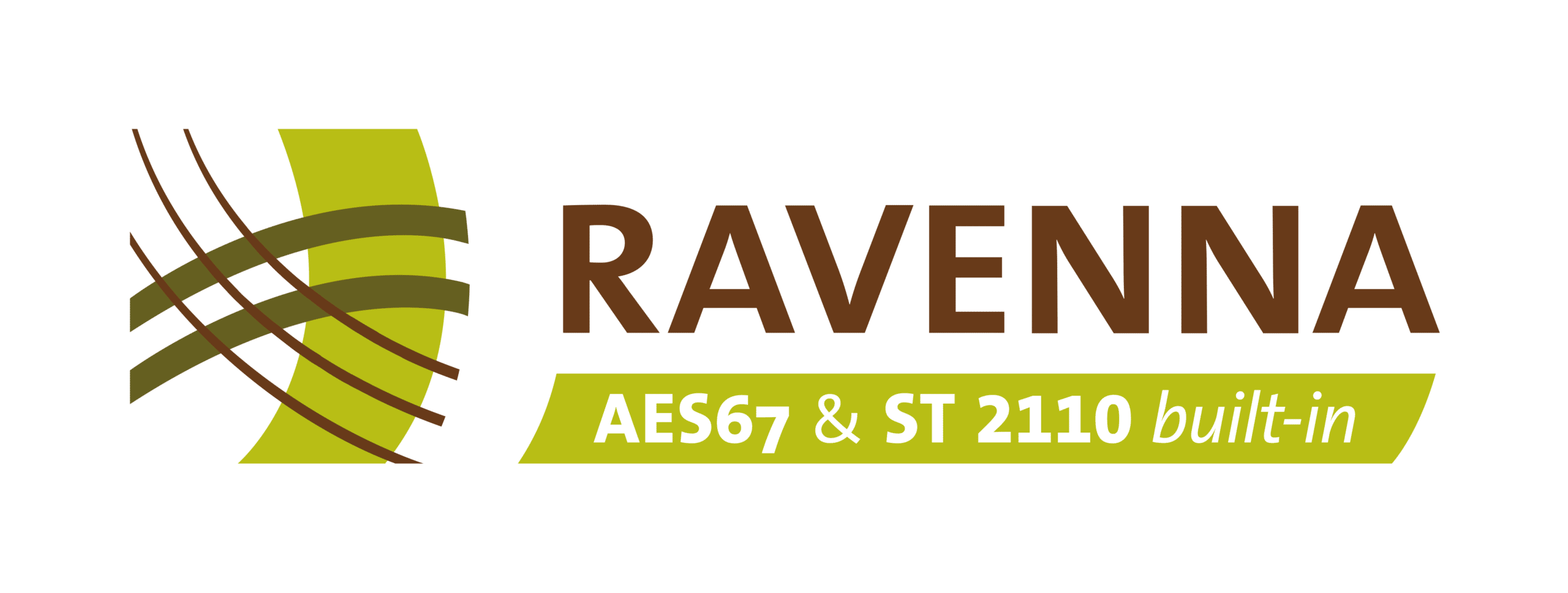Standards Comparison
RAVENNA, AES67 & SMPTE ST 2110
RAVENNA is a comprehensive audio networking protocol designed to give engineers enormous freedom on how to distribute audio. Almost every element can be tailored, from number of audio channels to sample rate and more. These different configurations are called ”profiles”, and you can have as many as you like.
AES67 is an interoperability standard to enable connectivity among various AoIP protocols such as RAVENNA, Livewire, Dante and others. As such, AES67 defines a constrained mandatory feature set which needs to be supported to provide connectivity among these AoIP protocols. SMPTE ST 2110-30 can be viewed as a variant of AES67. The general principles and requirements defined by ST 2110 are mostly identical to those of AES67; some differences and constraints are outlined below.
AES67 and ST 2110-30 are simply pre-defined profiles within RAVENNA. This is what ensures that RAVENNA is fully compatible with these standards.
Despite offering more flexibility, RAVENNA also includes features such as discovery and redundancy which are not defined in AES67 or ST 2110-30. RAVENNA also supports transparent transport of AES3 audio through its AM824 profile which has been adopted in the ST 2110-31 standard. Thus, using RAVENNA ensures complete compatibility for your audio at all times.
Feature | RAVENNA | AES67 | ST 2110-30 | ST 2110-31 |
Profiles | Unlimited* | 1 mandatory profile with some optional variations | 1 core profile with 6 conformance levels A(X), B(X), C(X) | 1 core profile with 6 conformance levels |
Media formats | 16/24-bit PCM, AES3, DSD/DXDats | 16/24-bit PCM | 16/24-bit PCM | AES3 |
Samples per packet | 1-192 | 48 mandatory, 6, 16, 192 optional | 48 (A) 6 (B, C) | 48 (A) 6 (B, C) |
Number of audio channels per stream | 1-64 (and beyond) | 1-8 | .1-8 (A, B)
1-64 (C) | 2 - 4 (A, B) 2 - 60 (C) |
Sample rates | 44.1, 48, 96, 192,
384 kHz | 48 kHz | 48 kHz 96 kHz (X) | 48 kHz 96 kHz (X) |
QoS classes | Adjustable | 3 w/ default values | 3 w/ default values | 3 w/ default values |
Discovery | Bonjour | None | None | None |
Redundancy | Yes | No | No | No |
PTP profiles | PTP default profile,
AES67 PTP media
profile, ST 2059-2 | PTP default profile, AES67 PTP media profile recommended | ST 2059-2 profile | ST 2059-2 profile |
Grandmaster | Elected via BMCA | Elected via BMCA | Follower-only mode by default | Follower-only mode by default |
IGMP | IGMPv2/3 | IGMPv2 | IGMPv3 | IGMPv3 |
Multicast address range | No stipulation | 239.0.0.0 -
239.255.255.255
| No stipulation | No stipulation |
*Including AES67, ST 2110-30, ST 2110-31 and DSD/DXD
PTP TIMING
RAVENNA/AES67 and ST 2110 all use PTPv2 (IEEE1588-2008) for distribution of a reference clock. However, AES67 mandates support of the PTP Default Profile and recommends support of the PTP Media Profile, whereas ST 2110 requires support of the PTP profile defined in ST2059-2. RAVENNA can work with any of these profiles.
AES report AES-R16-2016 is available from the AES which summarises the differences and commonalities between all 3 PTP profiles and offers recommendations for using a common profile on a converged network — learn more here.
FOLLOWER-ONLY MODE
ST 2110 requires a method to force a device into follower-only mode so it will never attempt to become an elected Grandmaster. RAVENNA & AES67 do not have this requirement and rely on the Best Master Clock Algorithm (BMCA) as defined in IEEE1588 to settle on a Grandmaster for a network.
REFERENCE CLOCK SIGNAL
Devices are usually referenced to a Grandmaster clock but ST 2110 allows a device to operate without a reference clock and just use a local clock. This state is signalled in the SDP of any outgoing stream.
CLOCK OFFSET
RAVENNA & AES67 follow RFC 3550, recommending a random offset between the media clock and the RTP clock. ST 2110 stipulates that the offset between the clocks shall be 0 to allow for faster restoration of streams after a device restart.
MULTICAST ADDRESS RANGE
AES67 explicitly calls for support of the administratively-scoped multicast address range 239.0.0.0 thru 239.255.255.255 for stream transport. ST 2110 does not stipulate any address range. If an address range other than the AES67 stipulated one is used in an ST 2110 setup, some AES67 devices which adhere strictly to the standard may not be interoperable in that particular network. RAVENNA also recommends using the administratively-scoped multicast address range, but is not constraint to it.
IGMP
All three protocols support multicast media streams. However, AES67 requires support for IGMPv2 whereas ST 2110 requires support of IGMPv3. IGMPv3 is designed to be interoperable with IGMPv2 and many network switches and routers can fallback to v2, but this could have an impact on stream delivery for parts or all of the network.
CONFORMANCE LEVELS
ST 2110-30 specifies six conformance levels (A/B/C/AX/BX/CX) with Level A being essentially AES67. The other levels are enhancements for different scenarios. RAVENNA can support all of them.
SMPTE ST 2110-30 is a subset of AES67, adding constraints to clocking and streaming
AES67 mandatory
a=ptime:1
AES67 optional
a=ptime:0.12
AES-R16-2016 PTP Confirguration
Option to operate device in PTP slave-only mode
a=mediaclk:direct=0
